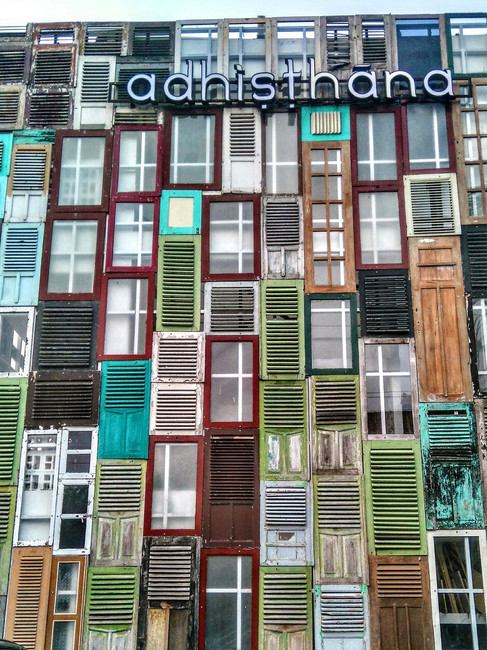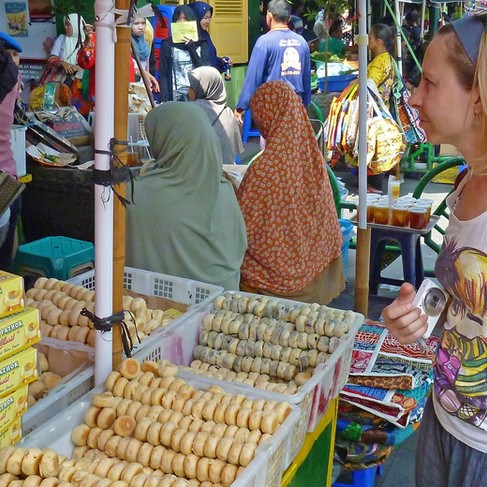We weren’t prepared for how much we would love Yogyakarta and somewhat regret spending only 2 days there. Nevertheless, we made the most of our time there and now have a place we would like to revisit on our return to Indonesia!
After we returned from our Prambanan Temple tour we once again made use of the Trans Jogja bus network with which you can get almost everywhere in Yogyakarta for only IDR 3 500.
RELATED POSTS:
We had booked accommodation in the funky Hotel Adhistana Jogja in the Danunegaran area south of Kraton for IDR 350 000 per night (USD 24) and can highly recommend them.

Yogyakarta - often called simply ‘Jogja’ (Y’s are pronounced like J’s in Bahasa), shares the name of the capital city of Jakarta yet they could not be more different! Jakarta has over nine million people in its hazy underbelly – interspersed with skyscraper malls and some of the most congested traffic you will find anywhere in the world. While Jogja retains a calmer soul, is culturally rich in ancient Javanese arts and home to less than half a million inhabitants. Yogyakarta today is home to the nation’s most prestigious university, a well-established art & music scene and picturesque landscape.
Yogya is a very manageable city to visit and many of its main sights can be seen on foot. This is a good walking map to follow if you want to retrace our steps.
Click the MAP to go to Google Earth
Or download Google KML file HERE
A good place to start a walking tour is from (A) Yogyakarta train station towards (B) Jl Malioboro, Yogya’s premier shopping street, which extends south towards the Kraton (sultan's palace).
Visiting Yogyakarta without strolling around Malioboro is like going to Paris without checking out the Eiffel Tower. You will find no shortage of Batik garments at the market (trousers, t-shirt, dresses, bangles and etc), sandals, blangkon (traditional central Javanese headdress worn by men and made of batik fabric) and much more to buy.

Malioboro can also be one of the best places in Yogya to sample cheap local food. There are plenty of Sego Kucing sellers around the street. Sego Kucing literally translates as 'cat rice', consisting of a portion of rice with toppings, usually dried fish, and tempeh, topped with spicy sauce (sambal), then wrapped in banana leaves. Luckily nothing to do with cats!
Jl Malioboro becomes Jl A Yani after the junction with Jl Suryatmajan. Visit the main market, (C) Pasar Beringharjo, to sniff unfamiliar spices and root around in the vegetable section; plenty local fruit and veg here may be unfamiliar to Westerners. We bought a box with a selection of fresh Bakpia Pathok on the outskirts of the market for IDR15 000. They are one of Yogyakarta's specialities named after Pathok suburb in this city where these sweet pastries originated.
Continue south to the city’s old Dutch fort, (D) Benteng Vredeburg, and pause for a picture under its impressive archway.
Cross Jl Senopati onto Jl Trikora and the (E) alun-alun (public square) will appear. Swing right, casting an eye over the Hindu statues in the courtyard of (F) Sono-Budoyo Museum, before heading south again, walking by the Javanese-inspired (G) Masjid Besar (GreatMosque) and the regal carriages of (H) Kareta Kraton Museum. The entrance to the (I) Kraton is only a few meters to the left.

The Kraton of Yogyakarta is the city’s palace complex and the main seat of the Sultan of Yogyakarta and his family - also serving as a cultural centre with a museum for the Sultan’s artefacts. More of a walled mini city than a palace, this compound is home to 25 000 people and has its own industries, schools and shops. Distinctive features to take note of is the male and female dragon entrances, along with the European-influenced architecture, gifts from various European monarchs and sacred banyan trees.

From the Kraton, head west until you reach the distinctive dragon arch of the (J) Taman Sari.
Also known as the Water Palace, it's a garden chateau with an elaborate series of swimming pools built by the Portuguese as a gift for the wives of Sultan Hamengku Buwono I. The castle boasts not only a magnificent view but a slightly eerie underground catacomb. Though it lacks some maintenance, it is still a great place just to wander around. Take your time to stroll around the maze of alleys, tiny shops and cafes to best explore this interesting part of Yogya.
From there make your way towards Jl Taman, which leads to the city’s southern (K) alun-alun, and try your luck walking between the square’s two banyan trees; folklore predicts good fortune for those who succeed. There are plenty of different myths about the challenge and it's said that if you can pass between the two trees with your eyes closed then whatever you ask for is going to come true!
If you are stuck for things to do during the evenings you should visit the southern alun-alun for some entertainment. You’ll be surprised how busy this place can be at night where you will mostly find Indonesian tourists and locals trying to walk between the twin trees, enjoying the night breezy weather, eating various local foods on offer around the park or riding super bling peddle ‘cars’.
These peddle cars are hilariously outrageous - the same size as a VW Beetle and covered with hundreds of bright lights and loud music. Some of the cars even come equipped with a small TV and you can rent a car to peddle around the park for fun. It costs around IDR 50 000 for one round trip for 4 people.

PART 1 Video of our month-long trip to Indonesia during 2016
This video shows us arriving in Jakarta and travelling via Yogyakarta and Surakarta (Solo) on to Mount Bromo near Probolingo and from there to Kawa Ijen near Banyuwangi. It was made before we started our Youtube channel and was mainly recorded using compact cameras.


















